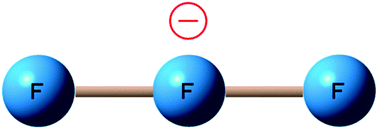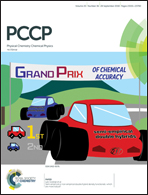Assignment of Raman spectra for trifluoride anions in solid argon
Abstract
Cesium fluoride evaporated from a small stainless steel Knudsen cell at 495 °C was codeposited with F2 in excess argon onto a copper wedge at 15 K and examined by focused blue argon ion laser lines scattered from the matrix sample. An 892 cm−1 Raman shifted signal was observed for F2, and stronger 461 cm−1 and weaker 389 cm−1 Raman shifted signals were observed for reaction products. All of these signals decreased in intensity upon prolonged exposure to laser light, but the 389 cm−1 signal decreased more rapidly than the 461 cm−1 signal. Temperature cycling to 40 K destroyed the 389 cm−1 signal, but the 461 cm−1 band remained intense, which was the same behavior for the very intense 550 cm−1 infrared absorption in similar experiments using a different instrument. The two strong 461 and 550 cm−1 bands related by annealing behavior were assigned to the symmetric and antisymmetric (F–F–F)− stretching modes for the trifluoride anion, respectively, in the Cs+F3− ion pair species with mutual exclusion. The weaker more vulnerable 389 cm−1 signal was attributed to an unknown, less stable (i.e. more reactive) secondary reaction product (Ault and Andrews, J. Am. Chem. Soc., 1976, 98, 1591). Nevertheless, Redeker, Beckers and Riedel (RSC Adv., 2015, 5, 106568), on the basis of the detection of a very weak assigned combination band and CCSD(T) frequency calculations, reassigned the two clearly unrelated strong 550 cm−1 IR and weak 389 cm−1 Raman bands to the same stable Cs+F3− ion pair species. We can now identify the weaker 389 cm−1 Raman band for a more photosensitive and reactive carrier as the isolated F3− anion. The required Raman blue laser photo-ionization of Cs and Rb atoms in the system and the case for this new assignment are considered in the following paper. The antisymmetric stretching frequency for this isolated anion has been assigned at 510.6 cm−1 in other IR work. We again assign with confidence the two strong and related 550 cm−1 IR and 461 cm−1 Raman bands to the same stable Cs+F3− ion pair species in solid argon.



 Please wait while we load your content...
Please wait while we load your content...